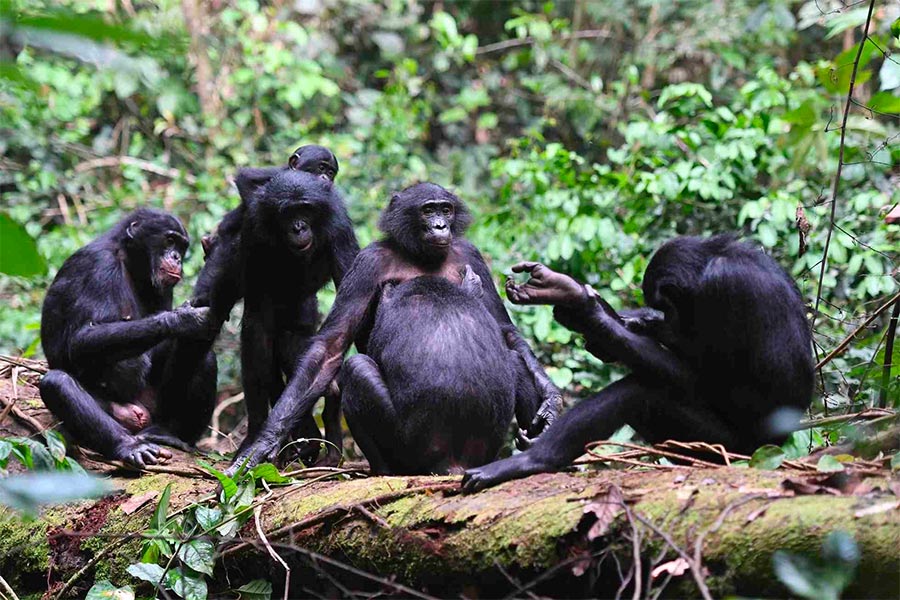- Natural selection has favored the evolution of physical traits and behavioral strategies to increase the benefits that they gain and reduce the costs that they incur from living in groups
- Group living is beneficial because there is safety in numbers and power in numbers
- Living in groups is also costly because of competition with other members and increases inbreeding
Highlights
Nearly all monkeys and apes live in relatively stable groups of known individuals. Orangutans are the only exception. We take this feature for granted because humans are very social creatures. But the primate order is actually rather unusual because the great majority of mammalian species are solitary. This raises the question: what are the benefits of living in groups?
Safety and power in numbers
Group living is beneficial because there is safety in numbers. Primates are preyed on by a wide range of predators, including eagles, lions, leopards, hyenas, crocodiles, and birds of prey. Animals in groups are likely to detect predators sooner than solitary individuals because there are more sets of eyes scanning for danger. Groups may also mount collective defenses against predators and mob them. If the predator does attack, the probability that a particular individual will be killed declines as group size increases. So, living in groups reduces the risk of predation.

Large group of baboons during a grooming session. Image credit Joan Silk
Living in groups is also beneficial because there is power in numbers. In nature, animals face competition for access to resources that they need to survive and reproduce. If animals in groups cooperate, they can exclude single individuals from valuable resources, like fruit trees or sleeping sites, and larger groups can exclude smaller groups. Thus, group living enhances success in between-group competition.
But there is a cost
Living in groups is costly because animals face competition with other members of their groups. Members of a group generally share access to a common home range or territory that contain the resources that they need. These resources are limited, and this may generate competition between group members and force individuals to compensate by spending more time and energy searching for food. This, then limits the amount of time and energy that they can devote to other activities such as caring for offspring or searching for mates.

Three adult female chimpanzees and their offspring feed on a red duiker after a successful hunt. Image credit Kevin Langergraber
Living in groups is also costly because it increases exposure to pathogens and infection disease. When animals live in social groups, they spend a lot of time in close quarters and some time in physical contact with one another, and this increases the chance that pathogens will be transmitted from one individual to another.
Living in groups increases the risk of breeding with kin (inbreeding). Inbreeding is disadvantageous because kin are similar genetically, and matings between close kin increase the chance that recessive genes that are linked to disease or disadvantageous traits will be expressed. If individuals remain in the groups in which they are born, they risk mating with close relatives.
Trade-offs
Ecological factors influence the tradeoffs associated with group living and generate variation in the size and composition of primate groups. Some primates live in groups that include one male, one female, and their offspring. The male and female form a stable pair bond and defend their territories against outsiders. Some primates form groups that include one adult male, several adult females, and immatures. In these groups, males often defend their position in the group against rival males, and males’ tenure in groups is relatively short. Others species form larger groups that contain multiple adult males, multiple adult females, and immatures. In these species, it is common for both sexes to form dominance hierarchies and for top-ranking males to sire more offspring than lower ranking males.

A group of bonobos. Image credit Martin Surbeck
Natural selection has favored the evolution of physical traits and behavioral strategies that enable individuals to increase the benefits that they gain and reduce the costs that they incur from living in groups. For example, in species that do not form pair bonds, there is competition among males over access to females, and this has favored the evolution of traits, such as body size and canine size, that increase male fighting ability or large testes that increase male sperm volume.
To reduce the risk of inbreeding, members of one or both sexes routinely leave their birth groups (disperse) when they reach the age of sexual maturity and move to new groups. Primates also demonstrate some forms of “behavioral immunity” that enable individuals to reduce their exposure to pathogens. For example, some primates avoid grooming animals that are infected with certain parasites.
In some species, individuals form close relationships that help them to cope with social challenges. These relationships play an important role in cooperative activities, such as grooming and alliance formation, and may play an important role in regulating stress.
Written by Joan Silk PhD